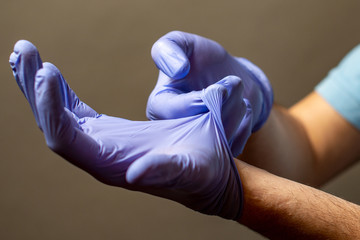In the world of hand protection, gloves are rarely just gloves. The choice between using silicone and latex gloves can make all the difference—especially in industries where health, safety, and hygienic practices are paramount. From the bustling kitchens of high-end restaurants to the sterile environments of hospitals, each material plays a key role in keeping hands safe and tasks efficient.
In this detailed post, we will dissect the advantages and best uses for both silicone and latex gloves, arming you with the knowledge to make the best choice for your specific needs. This guide is tailored for professionals in the food industry and healthcare sectors, as well as the growing community of home cooks who are increasingly conscious of personal safety and best practices.

Adding a Latex Glove to your Shopping List: Ensuring Safety with Every Touch
A Latex glove has long been a staple in environments that demand strict hygiene, from medical facilities to food handling areas. When it comes to enhancing your shopping list, you'll find that adding a box of latex gloves can be a straightforward task. Many stores and websites now offer a diverse range of latex glove products, making it easy to find exactly what you need with just a few clicks. The benefit of online shopping is the ability to compare a product, view detailed descriptions, and save items for later, all from the comfort of your home. Furthermore, websites often provide these products at comparatively low prices, enabling you to stock up on high-quality latex gloves without breaking the bank. Whether you're browsing through a store or a website, the convenience and efficiency of adding these essential items to your shopping cart cannot be underestimated.
Silicone Gloves: The Versatile Contenders
Silicone gloves, emerging as a newer challenger in the hand-wear domain, offer unique properties.
Silicone gloves are known for their durability and ability to withstand high temperatures, making them a go-to option for situations where other gloves could falter. They also boast a high level of flexibility, which is essential for detailed tasks that require dexterity.
In the Kitchen
Professional chefs and home cooks alike are taking note of silicone gloves for their heat resistance up to 500°F (260°C). They lend themselves well to various culinary activities, from grilling to baking, ensuring that no hot panhandle or oven rack poses a threat.
For Industrial Use
Silicone's endurance under extreme conditions, along with its resistance to tears and punctures, makes it a valuable asset in industrial settings. This material doesn't absorb liquids, making it easier to clean and allowing for repeated use without the risk of contamination.
Pros and Cons
Pros: High heat resistance, flexibility, durability, and the ability to be sterilised for intricate hygienic control.
Cons: High cost relative to other materials, less sensitive touch, and not biodegradable presents an environmental drawback.
Silicone Gloves: The Classic Standard
Lex gloves have been a mainstay in the medical and food industries for their excellent barrier protection properties.
Despite the increasing adoption of alternative materials, Silicone gloves remain popular for their superior fit, comfort, and tactile properties. They excel in providing a detailed sense of touch, which is crucial in medical diagnostics and surgery, where finding veins and other fine procedures requires precision.
In Healthcare
The elasticity and tactile sensitivity of Silicone gloves make them an indispensable tool in surgical and medical environments. They effectively block pathogens, providing a reliable barrier while allowing healthcare workers the precision needed for intricate procedures.
In the Food Industry
A latex glove, due to their snug fit and tactile sensitivity, are often the favored choice for food preparation. They allow for a good grip, making handling and preparing food safer and more hygienic.
Pros and Cons
Pros: Excellent sensitivity, fitting, and barrier protection against pathogens.
Cons: Latex allergies are common, and because of this, the material may not be suitable for everyone. Additionally, they are less resistant to tears and punctures compared to silicone gloves.

A Detailed Comparison and Information
The choice between silicone and latex gloves often comes down to the specific needs of the task at hand.
Durability and Flexibility
Silicone gloves outshine latex in terms of durability, withstanding repeated use, and demanding conditions without degradation. On the other hand, a latex glove offer better flexibility and comfort, which can be crucial for tasks that require prolonged wear.
Sensitivity and Cost
In terms of touch sensitivity, a latex glove is unparalleled, offering the ability to feel even the smallest of details. However, the cost of sensitivity is a higher susceptibility to tears and punctures. On the other hand, silicone gloves offer reasonable sensitivity but at a lower cost of maintenance and replacement.
Best Practices for Glove Selection and Use
Selecting the right gloves is not just about material; it involves a series of considerations that impact the efficacy of their use.
Factors to Consider
Task Complexity: For intricate tasks, the high dexterity of silicone might win over the superior touch offered by latex.
Potential Hazards: A realistic assessment of potential risks can steer you toward the material that offers better resistance.
Compliance with Regulations: Various industries have different compliance standards that specify the types of gloves required for certain tasks.
Safety and Hygiene Tips
Fit is Everything: A snug fit is critical to ensure that the gloves do not become a safety hazard themselves.
Proper Removal: Learning the correct way to remove gloves can significantly reduce the risk of contamination.
Hand Hygiene: Regardless of the glove material, hand hygiene is always crucial. Regular washing is imperative, especially before and after glove use.

Conclusion
The discussion about when to use silicone vs. a latex glove is intricate and multifaceted. By understanding the specific benefits of each material, you can make an informed decision that aligns with the standards of your industry and the needs of the task at hand.
For professionals in the food and healthcare domains, this guide is a tool to enhance safety protocols and performance. For home cooks, it serves as a valuable resource for upping the game in personal kitchen quests.
Remember, the gloves are not just a protective barrier; they are an extension of your professional arm and a commitment to safety and excellence.
